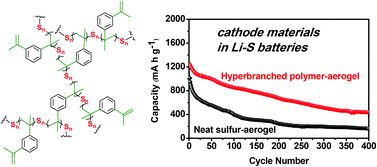Solution processible hyperbranched inverse-vulcanized polymers as new cathode materials in Li–S batteries†
Abstract
Soluble inverse-vulcanized hyperbranched polymers (SIVHPs) were synthesized via thiol–ene addition of polymeric sulfur (S8) radicals to 1,3-diisopropenylbenzene (DIB). Benefiting from their branched molecular architecture, SIVHPs presented excellent solubility in polar organic solvents with an ultrahigh concentration of 400 mg mL−1. After end-capping by sequential click chemistry of thiol–ene and Menschutkin quaternization reactions, we obtained water soluble SIVHPs for the first time. The sulfur-rich SIVHPs were employed as solution processible cathode-active materials for Li–S batteries, by facile fluid infiltration into conductive frameworks of graphene-based ultralight aerogels (GUAs). The SIVHPs-based cells showed high initial specific capacities of 1247.6 mA h g−1 with 400 charge–discharge cycles. The cells also demonstrated an excellent rate capability and a considerable depression of shuttle effect with stable coulombic efficiency of around 100%. The electrochemical performance of SIVHP in Li–S batteries overwhelmed the case of neat sulfur, due to the chemical fixation of sulfur. The combination of high solubility, structure flexibility, and superior electrochemical performance opens a door for the promising application of SIVHPs.


 Please wait while we load your content...
Please wait while we load your content...